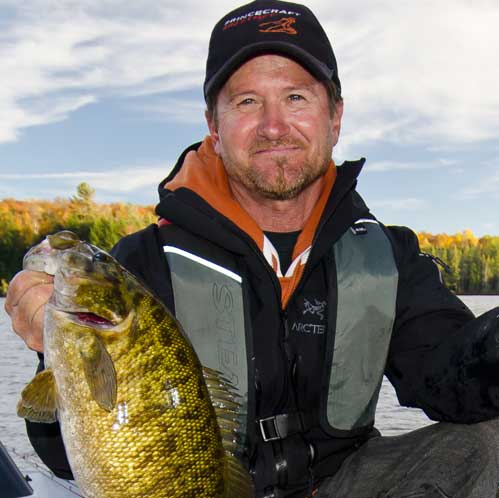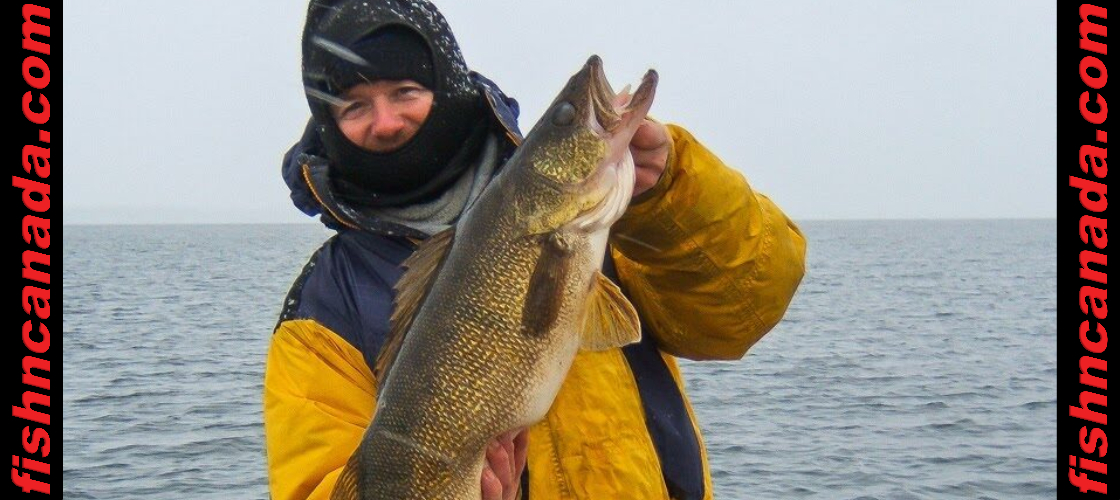Now, before I even get into this, I already may have some jigging enthusiasts “concerned” with the title of this article, but it came to me with good reason. In my opinion, the clearly noticeable “late season Walleye” trend is trolling crankbaits. Let’s be honest, the professional Walleye tour competitors, fishing guides, and anglers that simply want or need a change, have come to love pulling cranks in cold water. It’s a deadly way to get ’em!
The Bay of Quinte is a perfect example of this trend. Come October, through November, and well into December, trolling crankbaits has yielded more trophy Quinte area Walleye than all other tactics combined. I would venture to bet that if you compared the amount of 10 pound plus Walleye caught trolling crankbaits in the last 20 years, to 10 pound plus Walleye caught on jigs in the last 40 years, the trollers would win. Do the math yourself if you have a steep history of fishing fall Walleye on the bay. Personally, my jig numbers don’t even come close to my trolling numbers when it comes to big fish.
Does this mean that the art of jigging fall Walleye is lost? Are locations like the Bay of Quinte an indicator that Walleye jigging is a waste of time?
Definitely not!
My personal history of jigging up cold water fall Walleye is a long one. It used to be my go-to tactic no matter the conditions or depth. Whether it be a jig and minnow, a jigging spoon, or an ice jig – to me, that was the deal. I say “was” because as you see above, I now have also employed the trolling crankbaits pattern into my arsenal of fall Walleye fishing strategies.
Now, if you were to ask me which method I’d rather catch a late-season open water Walleye on (jigging vs trolling cranks), I would most definitely choose jigging. Just the hit alone is so rewarding. And then setting the hook on medium action spinning gear and having that rod double over and “stop”… there’s no better feeling in Walleye fishing. I have great fishing memories of sitting in 15-16 feet of water on frigid November evenings, feeling that “tap” of a Walleye sucking in my jig and minnow, and then setting the hook into what honestly felt like bottom… until that head started to shake. What a feeling that is!
MY FAVOURITE GEAR FOR FALL WALLEYE JIGGING
Rods & Reels:
As I stated above, I prefer using spinning gear for the most part when jigging fall Walleye. A 6’ 8″ to 7’ medium-fast action quality graphite rod coupled with a 2000-sized spinning reel is perfect. Spool up either straight 8lb test, 100% fluorocarbon line to the jig, or 10 – 12lb braid to an 8 or 10lb fluorocarbon leader (my personal preference) to the jig and you’re in business. I’ve been tying the FG knot lately for the latter braid to fluoro setup and I really like it (keep practicing until you get it).
I do have a time when I use baitcasting gear instead of spinning. When I’m using heavy jigs in deep water, that’s when I make the switch. Three-quarters of an ounce and up is my threshold here. I really don’t like the feel of spinning gear with a heavy jig; it’s just a personal preference.
For my baitcasting setup, I like a 6’10” to 7’ medium-heavy rod and a reel, with either 12 – 15lb straight fluorocarbon or 20 – 30lb braid to a 10 – 12lb fluorocarbon leader. Yes, medium-heavy sounds like a lot of stick for Walleye, however, there’s a great chance at a real tank of a fish with a heavy jigging lure so I feel heavier is better than lighter.
Incidentally, I tie my leadhead jigs directly to the fluoro with a Palomar knot and if I’m using a jigging spoon, I sometimes tie on a small snap-swivel first (if the spoon has a crazy action), again, with the same knot.
Leadhead Jigs
As for jigs, I don’t let it get too complicated. Since I mostly use a leadhead jig and minnow combination, I prefer a short-shank hook, however, a regular length hook is totally fine. I feel the short-shank is easier for a fish to engulf the entire presentation into its (hopefully) “big” mouth and thus feel I get more of a chance of hooking up. As well, if I can get a stand-up short shank hook, all the better. On those ultra-slow days where bottom contact is crucial, I like the fact that my minnow is in the nose down position, meaning the rest of the body and tail is sticking up from the bottom. Maybe that’s just in my head but I like it that way!
Brands of lead head jigs again are a personal thing. Just make sure you buy quality.
Jigging Spoons
Jigging spoons have been around forever and, here in Canada, they have always been a staple of ice fishing. From panfish all the way up to Lake Trout, jigging spoons catch ‘em!
In usual experimental angler fashion though, many have taken the jigging spoon to open water (me included).
For Walleye, I prefer a ½ ounce size in most instances. If I’m fishing 30+ feet deep in a strong wind, I’ll go heavier. Again, I “ALWAYS” tip my jig with a minnow at this time of year. Well, maybe I shouldn’t say always. If the fishing is insanely good and the Walleye are pounding the spoon/minnow combo, I’ll attempt to try it bare without a minnow. The Walleye will quickly tell you if the need for meat is necessary.
I actually like the “gold in overcast and silver in sunny” rule of thumb here. Of course, fluorescent orange, chartreuse, white and patterns like perch or even those crazy colours are also great producers. Keep an array in your jigging kit.
Ice Jigs
Ice fishing jigs are another great fall Walleye producer (all season in fact). Not to be confused with jigging spoons, these oddly shaped baits are fish triggering machines. I’m not too sure what company started the craze, however, it was Rapala that certainly put these baits on the map. Other companies like Nils Master, Acme, and Moonshine all make quality products. As I said above, these most definitely should not be targeted to ice fishing only. With that said, fall is one of my favourite months for bringing out the ice jigs. There’s something about the action of this bait that gets Walleye cranked up!
Again, tipping this bait with a minnow, or at least a minnow head or tail, can make all the difference in the world. However, in the opposite fashion of my jigging spoon technique, in where I add a minnow (or piece) and let the fish tell me if I don’t need it, with an ice jig I fish it bare and then add the minnow on and slow things down if the fishing is slow and I know I’m over or close to Walleye.
Lipless Cranks (Rattle Baits)
My final fall jigging bait is a lipless crankbait, formerly (and still) known as a rattle bait. I love the fact that someone had the wherewithal to take a bait that was designed for Largemouth Bass (and transitioned extremely well for Smallmouth), and put it to effective use on Walleye. To me, that’s brilliant!
In the modern-day cold water Walleye era, there are now vertical jigging Rattle Baits designed specifically for Walleye. Companies like Yo-Zuri put out great lures.
The first time I heard about these baits being used in the cold water period was from ice anglers on Lake Winnipeg. They were triggering giant Walleye when everything else was mediocre at best. It quickly became an on-ice phenomenon.
Although I’ve only dabbled in the lipless crank world for fall Walleye, it has worked on a few fish. When the fish are ultra-aggressive and, believe it or not, when they don’t seem to want anything to do with a jig and minnow, that’s when I will change. It’s all about experimentation.
WHERE TO JIG IN THE FALL
I’m not going to get specific here in which lakes or rivers to jig fish but I will say that the spring spawn has a huge influence on where to fish. Walleye of all sizes will work their way towards their spawning grounds. I like to look for a nice deep hole or basin near any incoming rivers. Between that deep hole (ideally around 20-40+ feet), some breaklines along a channel, some humps that top out around 20 or so feet deep, and the first 500 to 1000 meters of the spawning river (from the river mouth and up current) are where I would start.
A major key here is to use your electronics to the best that you can. Start out using your fishing chart screen to see potential areas. If you like your traditional screen then activate it and look for hooks or bumps on the bottom. The same goes with scanning down and to the sides. Of course, if you have any of the Panoptix transducers, that makes life even easier.
No matter what area of the lake or river that I commence my fishing day in, I pretty much always start with the jig and minnow combo. That’s simply because, if they aren’t hitting that, then I’ve got my work cut out for me.
CONCLUSION
I’ll leave it up to you as to if you feel jigging for fall Walleye is a lost art. For me, I’d take one 10 pounder on a jig vs. two trolling a crankbait any day of the week. Don’t get me wrong though, I will do whatever tactic is necessary to put a giant into the boat, it all just boils down to preference.





